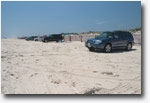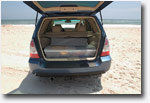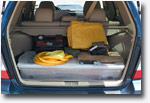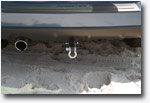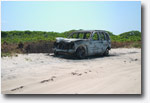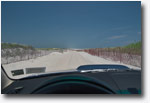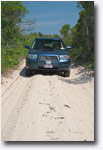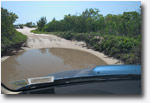On the Beach in a Forester |
Note - the thumbnails below are links to larger images.
No doubt, Subaru vehicles offer tremendous versatility and their AWD systems remain among the best available today. It should therefore come as no surprise that when properly equipped and driven, many Subaru models handle deep, soft sand quite competently.
As a resident of Long Island, NY, we have vehicle access to many miles of ocean-front beaches at county and state parks. Though this access is regulated and has certain restrictions, it has been a favorite pastime of mine for many years, long before I became a Subaru owner. My first ventures on the beach were with a 1996 Jeep Cherokee XJ, which turned out to be an extremely capable vehicle for that task. Its short wheelbase, light weight, good ground clearance, capable 4-wheel drive train (manually-engaged transfer case) and P235/75R-15 all terrain tires made the Jeep XJ virtually unstoppable. After loosing the Jeep XJ in an accident, we acquired a 2000 Jeep Grand Cherokee with the Quadratrak ll system, which wasn’t quite as good as the XJ in soft sand but still up to the task. We never got stuck with either of those vehicles in our many excursions to the beach, but I have seen many other people get stuck in everything from Lexus SUVs to large 4X4 pickup trucks. As is the case with many other endeavors, equipment is important but technique plays a large role as well.
Since getting my 2007 Forester XT, the idea of trying it on the soft sand of Fire Island (the barrier island that runs parallel to the south shore of Long Island and contains most of the accessible beach) has intrigued me. Having moved to the FXT from a 2006 WRX, its higher ground clearance, higher profile tires and Subaru’s renowned AWD system made me believe that it may do reasonably well. At the same time, driving through soft sand places the entire drive train under far more stress than what is normally encountered on the road, and having driven only Jeeps with “heavy duty” 4-wheel drive trains I remained somewhat skeptical of what the results might be.
There are several important considerations for driving any vehicle in deep, soft sand;
- Floatation – this is the ability of the tires to support the weight of the vehicle without sinking into the sand. The more square inches of contact area the tire has with the sand, the more area weight is distributed over – resulting in better floatation.
The contact area of a tire on sand can be dramatically increased by deflating the tire to the point that the shoulder area comes in contact with the sand and supports some of the weight. This is why anyone experienced with beach driving will tell you that “airing down” is so important. The downside of “airing down” is that it slightly reduces tire height and thus ground clearance.
- Ground clearance – on a paved road not much clearance is needed, but soft, deep sand is a different story. The surface of the typical beach is anything but smooth and flat, and the deep tracks left by other vehicles that often have to be driven through require a certain amount of clearance under the vehicle. A vehicle can have big tires/great floatation and an excellent 4-wheel drive system but if it ends up resting on its undercarriage instead of on its tires, none of that will make any difference.
- AWD – as handy as it is, just because your car has AWD does not mean it will do well on soft sand. In fact, the typical “dune buggy” is rear wheel drive only, but due to its light weight and large ties, it gets the job done with excellent floatation alone. That said, the typical vehicle requires AWD to help overcome minor shortcomings in floatation/ground clearance.
An on-paper comparison of the Forester to our old Jeep XJ shows that the Jeep was a few hundred pounds lighter, had better ground clearance and larger tires, making it apparent that the Forester will be no match in the toughest soft-sand conditions. Compared to our Grand Cherokee, the Forester is over 600 pounds lighter, has comparable ground clearance but smaller tires. Overall, I was convinced that as long as I did my part and didn’t push the Forester beyond its limitations, that it should do at least as well as our Grand Cherokee, but I would need to avoid the really tough spots that the Jeep XJ handled well. It turns out that I was right.
|
Driving the Forester in Soft Sand
Before we proceed with this section, here are a few other points to consider;
- In terms of ground clearance, a stock Forester is “barely adequate” for driving in soft sand. If you have lowered your Forester for on-road handling performance, you may no longer have adequate ground clearance for beach driving.
- Due to strut-clearance considerations, there is a limit to how large of a tire (in both width and height) you can put on a Forester without major modifications. At any given width, a higher profile tire with its taller, more flexible sidewall will produce more tread contact area with the sand when aired down. A “plus 1” sized tire, such as a P225/60R-16 is probably as good as it’s going to get for driving in soft sand.
- Make sure your car is in top-notch mechanical condition before driving in sand. Pay special attention to any driveline or engine cooling issues as both of these systems will be placed under higher stress. If, for example, you have a slipping clutch or an overheating problem when street driving, do not attempt driving in soft sand until the problems are addressed.
- Make sure your full size spare tire is in good condition. Temporary spares do not do well in the sand!
- Generally speaking, cars equipped with automatic transmissions do better in soft sand as torque can be applied gradually and evenly without fear of slipping/burning the clutch. The addition of an auxillary transmission cooler (automatic transmissions) is a good idea.
Before heading out for soft sand driving, some important items should be placed in the car in the event of problems. Minimally, the following should be carried with you;
- Cell phone
- Shovel
- Recovery strap (not a "tow strap"!)
- Scissor jack
- Jack board
- Fire extinguisher
- Flashlight
- Portable air compressor
- Tire pressure gauge
- First aid kit
Additionally, I carry a rain parka, a standard tow rope with hooks (not to be used for recovery!) and a small selection of hand tools, including a breaker bar and socket for lug nuts. If you are driving in isolated areas, let someone know where you are going and when you expect to return. If you are driving in cold weather, bring warm clothes and/or a winter sleeping bag. Optional but handy vehicle accessories include full coverage floor mats, windshield sunscreen, transmission cooler (automatics) and trailer hitch (see below).
Driving Technique
So your Subaru is properly equipped, in good mechanical condition and you have the items listed above stowed in the car. Upon reaching your soft-sand destination;
- Air down! Using your high quality tire pressure gauge, deflate all tires to around 17 PSI. This is low enough to allow the sidewalls to flex for maximum contact with the sand, yet high enough to maintain the bead. I have deflated as low as 15 PSI without problems.
- Take it easy! Apply throttle gradually to avoid tire spin. Keep speed under 15 MPH to avoid loosing the bead on a tire and to avoid tire overheating. Driving at high speed on a beach may not only be illegal, but greatly increases the chances of roilling your vehicle as well. Slow down even further when making turns.
- Watch for “high center” situations! This often occurs when driving over high spots in the sand or through deep tracks left by other (higher and heavier) vehicles. If you must drive along deep tracks, hug the edges of the tracks to avoid the deeper center area. If you must drive across deep tracks, do so at an angle to avoid getting more than one wheel in the deep tracks at the same time.
- Maintain momentum! In the softest/deepest sand, maintain forward motion and try to avoid coming to a complete stop.
- Stay out of the surf! That is the last place you want to be stuck or broken down when the tide is rising.
- Gravity can be your friend – or foe! Going uphill in deep, soft sand is by far the most difficult for any vehicle. Always remember that your vehicle will be easier to move downhill than up. Beware of downhill areas that may leave you trapped in a low spot you can’t get out of.
- Get to know your limits and capabilities! When I first drove my Forester on the beach, I picked the hardest-packed, flattest areas to come to a full stop, and then gradually applied throttle to start moving again. I kept doing the same on gradually more challenging surfaces to get a feel for what my Forester could do. With a bit of driving experience, you develop a feel for what your vehicle can handle and what it struggles with – and what areas you can confidently drive through and which you should avoid.
Getting Unstuck
Though I have never gotten stuck with any of the vehicles I have driven on the beach, I have to accept that fact that it could still happen.
The first sign of trouble will be wheel spin – once you loose traction, you are in trouble. If you loose traction and come to a stop;
- Don’t panic! The last thing you want to do is get on the throttle in panic mode and dig yourself deeper. On sand, wheel spin is your enemy!
- Get out of the vehicle and survey the situation. Many times, it may be just one wheel that has dug in holding the vehicle from moving. As long as the vehicle is not resting on its undercarriage, extraction should be easy. Use your shovel to clear a path for the tire that is dug in, and then try pulling out again. If you are on an incline, use gravity to your advantage by driving downhill to get freed. Once you are free, drive through the trouble spot at higher speed, or perhaps better yet, find an alternative path.
In more severe cases, when your vehicle is hopelessly resting on its undercarriage, one man extraction is still possible but it will take some time and work. The idea is to get the vehicle weight placed back on the wheels and gain some ground clearance under the vehicle. Use your shovel to clear an area under the vehicle to safely reach in and place the jack board and jack under the axle. On the Forester and most other Subarus, the rear differential housing is an approved jacking point. In the front, the jacking plate under the engine, or the subframe under the attachment points. You could also use the stock jack/jacking points in concert with the scissor jack to raise the car. The goal is to lift the tires – one at a time - out of their depressions and then use your shovel to backfill the holes under the tires. It will take some time and effort, but once you have raised the car and it’s resting on all four wheels with at least a few inches of undercarriage clearance, ascertain the best direction to move in. In some cases, this may be backwards though the area you previously drove though. In other cases, it may be forward if the area ahead looks more manageable. In either case, apply throttle gradually to avoid wheel spin and build as much speed/momentum as is prudent to get out of the tough area.
In other cases, the recovery strap may be useful if there is another vehicle available to pull you out. Unfortunately, there are not many good spots on a stock Forester to attach a recovery strap (never attach a recovery strap to any driveline components, such as an axle or strut!). If driving on the beach will be a regular activity, consider installing a tow hitch on the vehicle, which can serve as a good attachment point.
When using a recovery strap, the recovery vehicle should line up so its attachment point is inline with the attachment point on your Subaru. The idea is to pull straight, not at an angle which is more likely to bend something. Once the strap is attached, have the recovery vehicle pull enough slack out of the strap so that it is no longer resting on the ground and then stop. At this point, get in your car, place it in gear and apply throttle without spinning the wheels. The recovery vehicle should then begin pulling slowly and adding tension to the strap. The recovery strap will continue to stretch until there is enough tension to “snap” your vehicle out. Be sure to coordinate this procedure with the driver of the recovery vehicle. If a third person is available, they can stand to the side and serve as a coordinator for the process.
When leaving the beach, don’t forget to inflate your tires back to the recommended levels. Driving on under inflated tires on the street is dangerous and can result in tire damage or blow-out. This is where a good portable air pump will make the job fast and easy. When you get home, give your Subaru a good wash, including hosing down the undercarriage and wheel well areas.
Have Fun!
With a bit of preparation, taking the time to learn the tricks of driving on soft sand, and learning the abilities/limitations of your vehicle, driving on the beach can be a fun and rewarding experience. My wife and I often find ourselves visiting the beach on an early Sunday morning to enjoy the solitude, or taking friends out for an evening cook-out. In any case, showing up with a Subaru in a place normally visited by only “proper 4-wheel drive vehicles” is worth the trip in itself!
Note - my thanks to the participants on the Subaru Forester Owners' Forum for their input on this instructional article.
